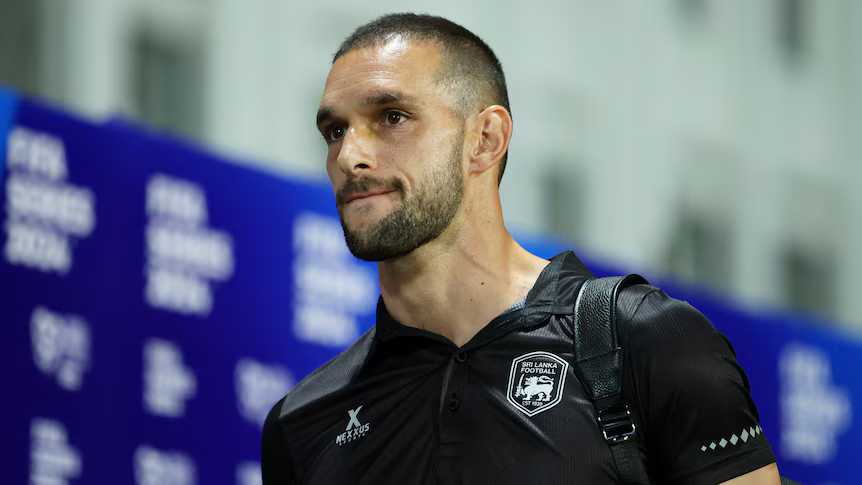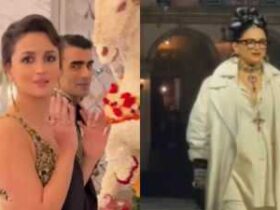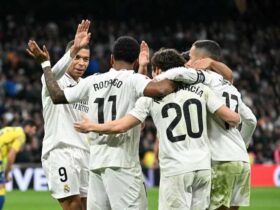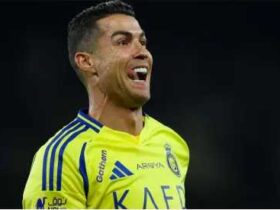With almost 50 FIFA rankings separating the two sides, Sri Lanka’s 1-0 defeat of Yemen was world football’s biggest upset of the November international break.
And at the heart of it all was Brisbane Roar stalwart Jack Hingert.
In an essentially empty Al Khor stadium in north-eastern Qatar, a long throw into the box was flicked onto a stooping Hingert, who nodded home to win the day.
The 89th-minute goal was his first for Sri Lanka and the so-far crowning moment of the 34-year-old’s fledgling international career.
It was only a friendly, but you could see what it meant to the Golden Army, as the men’s national team is known.
Hingert barely had time to wheel away in celebration before he was engulfed by an ecstatic cloud of teammates, bench-warmers and coaching staff alike.
For much of its history, the world’s 200th ranked national team (out of 210) has been little more than a footballing footnote, having never even come close to qualifying for a major international tournament.
And in recent years, political instability in the country, a FIFA ban, and the COVID pandemic have stymied any potential development.
But now, Hingert is a key figure in the rebirth of Sri Lankan football.
It’s a role he never anticipated being cast in, but one that means more than any he has played on a football field before.
“You’re not just representing a city, a town, a state — you’re representing the people of a whole country, it’s a different kind of responsibility,” Hingert told ABC Sport.
“You’re representing your family.”
Sri Lankan family ties
Hingert isn’t sure how Football Federation Sri Lanka (FFSL) got wind of his heritage.
Born in London, he moved to Melbourne as a teenager and has gone on to play almost the entirety of his professional career in Queensland.
So, any clues to his international eligibility were seemingly well hidden.
But in 2020, an approach was made by then Sri Lanka manager Amir Alagic.
Hingert’s connection to Sri Lanka is through his father, who was born in the country and is of Burgher descent.
Sri Lankan Burghers are a small ethnic group of mixed Dutch, Portuguese and Sri Lankan ancestry, many of whom now live in diaspora communities across the world.
Hingert’s father emigrated in the 60s, but his, and his son’s, connection to the country has stayed strong.
Much of their family remains in Sri Lanka, some of whom still own a restaurant on the beach in Colombo.
But a considerable amount also immigrated to London, and then Melbourne, at similar times to Hingert’s immediate family.
“Every family party, it was all Sri Lankan, and because we’ve got such a big Sri Lankan family there [in Melbourne], there was a family party nearly every weekend,” Hingert said.
“It’s been a huge part of my life from day one.”
Upon taking over as national team boss in 2020, Alagic set out to identify players with Sri Lankan heritage competing abroad, hoping to bolster the country’s largely semi-professional talent pool.
Since then, Hingert is one of at least 10 players from the diaspora to have become a part of the Sri Lankan football furniture.
Also among them is Australian-born free agent Oliver Kelaart, who last plied his trade in the Icelandic third tier, and perhaps the highest profile is German third division player Claudio Kammerknecht.
Foreign-born players have always played a significant role in national teams around the world.
A study looking at the 10,137 players to compete at a men’s World Cup between 1930 and 2018 found that just under 10 per cent of them represented a country other than the one they were born in.
And at the 2022 edition of the tournament, in no small thanks to a Qatari team that featured a glut of naturalised nationals, that percentage was more than 16.










Leave a Reply